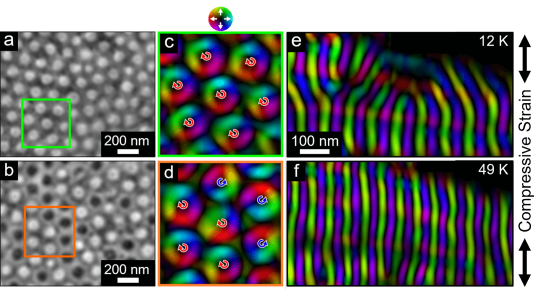
Scientific Achievement
Strain and topography are shown to control magnetic bubble lattices in a van der Waals ferromagnet.
Significance and Impact
Control of global topology and magnetic domain structures in 2D materials is of fundamental importance when creating multilayer heterostructures for potential devices or studies of novel interface physics
Research Details
- Magnetic domain structures were observed in van der Waals Cr2Ge2Te6 (CGT) using in situ cryo-Lorentz transmission electron microscopy at temperatures as low as 12 K.
- Exfoliated flakes were observed to support both topologically-protected and topologically-trivial bubble domains.
- Magnetoelastic coupling between strain and the magnetization was observed in strained flakes, wherein bubble lattices and stripe domains aligned along the strain axis near the transition temperature, Tc.
Argonne National Laboratory seeks solutions to pressing national problems in science and technology. The nation’s first national laboratory, Argonne conducts leading-edge basic and applied scientific research in virtually every scientific discipline. Argonne researchers work closely with researchers from hundreds of companies, universities, and federal, state and municipal agencies to help them solve their specific problems, advance America’s scientific leadership and prepare the nation for a better future. With employees from more than 60 nations, Argonne is managed by UChicago Argonne, LLC for the U.S. Department of Energy’s Office of Science.
The U.S. Department of Energy’s Office of Science is the single largest supporter of basic research in the physical sciences in the United States and is working to address some of the most pressing challenges of our time. For more information, visit https://energy.gov/science.